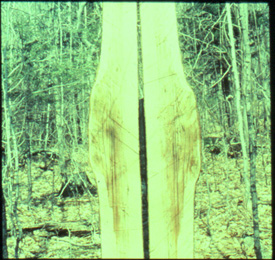
| Home |
| Tutorial |
| Photo Gallery |
| List of Defects |
| Links |
| Bark Distortion |
| Bird Peck |
| Bumps |
| Burls |
| Butt Scars |
| Butt Swells |
| Cankers |
| Conks |
| Epicormic Branches |
| Flanges |
| Flutes |
| Forks |
| Galls |
| Holes |
| Knots |
| Lesions |
| Limbs |
| Ring Shake |
| Rot |
| Seams |
| Soak |
| Splits |
| Wounds |
Stem bulge is not as common as butt bulge but can be found on any species. It is most conspicuous on ash and elm.
Butt Bulge is nearly always accompanied by a hollow butt. Rot commonly extends above the holow, and the upper tapered-off limit of the bulge generally indicates the end of serious rot. It is found most often on lowland sites with high soil moisture content and is most frequent in oak.
In ash, elm, maple, sweetgum, and similar hardwoods, massive butt rott may not produce a clearly outlined butt bulge, Also, in these species the bark over even a slight bulge often becomes smoother and darker, with many more cross breaks than usual. Such bark scales slough off much faster than from a normal sound stem. Sweetgum is an outstanding example of this.

Significance- Bulges are usually evidence of internal rot and under good bucking practice are not included in logs if the rot takes up more than 50% of the end area of the log. Even though the rot may allow chucking, both types of bulges are damaging in veneer logs because they cause short veneer before the log is rounded up. Elimination of butt bulge is made by locating the first bucking cut above the damaged part of the stem. A stem bulge located near the middle of a log, where it cannot be cut out , is a degrader in factory-lumber logs. Also the quantity of lost or damaged wood must be deducted from the gross scale. A stem bulge disqulaifies a log otherwise fit for contruction material. In local-use logs, the bulges are overlooked if the associated rot does not exceed the scaling deduction limits for the class. The identification and evaluation of bulges is most serious during the appraisal of standing timber, especially when analyzing the tree for multiple products.

